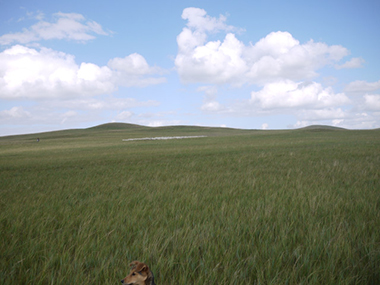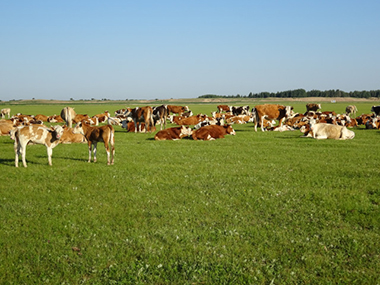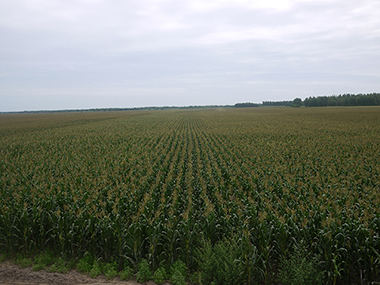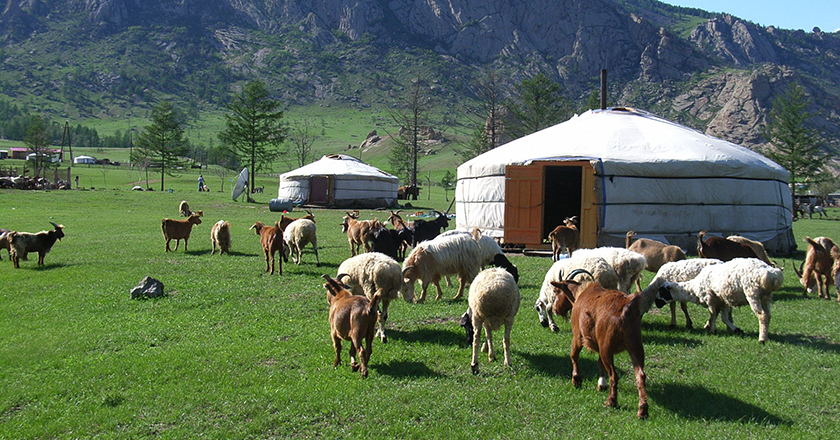The change from nomadism to half-farming and half-pastoral farming that began in Inner Mongolia
One of my research themes is agriculture in the Inner Mongolia Autonomous Region (Inner Mongolia). At first glance, this seems to be a subject that has little to do with Japan, but as we continue our research, we find that there are many implications for Japanese agriculture.
In the first place, Mongolians who were nomadic people, were forced to farm in Inner Mongolia.
Looking back at history, in the 13th century, the Mongolian Empire took over China and established Yuan, but in the 17th century, during the Qing Dynasty, the Mongolian Empire, including present-day Mongolia, came under the control of the Qing Dynasty. During this period, from the perspective of the Qing dynasty, the nearby regions and the distant regions got to be called respectively Inner Mongolia and Outer Mongolia.
Later, in the middle of the 19th century, Han Chinese farmers who had been impoverished due to wars and other factors, fled to the Inner Mongolia region and settled there. As they cultivated land for agriculture, they came into conflict with the nomadic Mongolian people.
However, as the Han Chinese population grew in the eastern part of Inner Mongolia, the Mongols were driven away to central and Outer Mongolia.

These external pressures first made it difficult for the Mongols who remained in the eastern part of the country to graze, and they began to follow the lead of the Han Chinese in crop farming. In addition, as the number of nomadic Mongols in the central region increased, the nomadic area in the region became smaller, forcing them to begin settled pastoralism.
In 1932, Manchukuo was created, and the eastern part of Inner Mongolia became a part of it. The Japanese who came to the area improved the varieties of soybeans and other crops for export to Japan, which led to an increase in production, and the Mongols also began to focus on crop farming.
Later, Outer Mongolia became independent as the Mongolian People’s Republic (the name was changed to “Mongolia” in 1992), and Inner Mongolia became an autonomous region of China.
In fact, even today, nomadism is still the mainstay in Mongolia. On the other hand, the focus is on crop farming in the eastern part of Inner Mongolia, but what cannot be overlooked here is that the Mongols in that area have never stopped pastoralism. Although grazing became difficult, herders began to house mainly cattle and sheep.
In other words, it is a half-farming and half-pastoral farming with both crop farming and pastoral farming. This is a major characteristic of Mongolian agriculture in the eastern region of Inner Mongolia. The grassland area is limited to two areas: the central part (Shilingol) and the plateau area (part of Hulunbuir) to the west of the Daxing Anling Mountains. In particular, Shilingol is mainly a pastoral industry that relies on natural pasture grass, and the percentage of crop farming is low.
Corn brought prosperity to Inner Mongolia

The Chinese Communist Party unified China, and the Great Leap Forward began in 1958. This was a radical socialist construction movement based on Mao Zedong’s ideology, and a People’s communes were established in Inner Mongolia to promote the expansion of agricultural production.
In reality, however, as in other parts of China, the Great Leap Forward failed to materialize. The data shows that the yield per unit area was higher during the Manchukuo period. The peasants could not achieve affluence and remained mostly self-sufficient.
This situation began to change in the 1980s with the Chinese economic reform, which led to the contract production system of individual households.
In China, private ownership of land is not allowed. That has not changed, but with the economic reform, rural land became collectively owned by the village committee, which then allocated the right to contract management for farmland and livestock ownership to each farmer in the village.
In the beginning, there was a rule that farmers had to sell crops to the state, but gradually they were allowed to sell them freely. In other words, farmers gained independent management rights (family business). It goes without saying that this was an incentive.
The cultivated area of Inner Mongolia, which was about 3 million hectares in the 1950s, has continued to expand since the economic reform, and now exceeds 9 million hectares. By way of comparison, Japan’s cultivated land area is about 4.5 million hectares, so it is twice as large as Japan’s.
Also, in the early 1980s, farmers grew soybeans, corn, mung beans, red beans, and a variety of millet, including foxtail millet and common millet, but with the increase in the market price of corn in the late 1980s, corn cultivation became the main crop.
These changes brought affluence to the farmers of Inner Mongolia. In addition to these, sustainable half-farming and half-pastoral farming could be realized.
As mentioned earlier, Mongolian farmers kept their herds in sheds, but unlike grazing, it requires a large amount of feed. For farmers, that is a huge burden.
However, when corn became the center of cultivation, the kernels were naturally sold to the market, but the remaining leaves and stalks were cut into small pieces or stored and fermented in silos to make silage, which became fodder for livestock.
There used to be a cycle of making these self-sufficient feeds and compost in rural Japan. However, the dwindling farming population shunned these labor-intensive tasks and began to purchase both feed and fertilizer from outside.
In Inner Mongolia, this cycle persists because an efficient division of labor has been established within rural communities.
Thinking about agriculture on the assumption that crops can no longer be imported

In fact, many farmers in Inner Mongolia devote their labor to raising livestock.
The reason for this is that farmers were poor in the past, and livestock also served as draft animals, which prevented the introduction of farm machinery. However, when a farmer who had a little more leeway introduced a large machine, the surrounding farmers began to outsource the heavy labor of farm work to the owner of it.
Then, the farmers who owned the machines were paid for their work, and those who outsourced the work could use their labor to raise livestock.
This division of labor was made possible by the expansion of the scale of operations, which was due to increased cultivation under the control of the village committee. It enabled them to use large machines efficiently.
On the other hand, in Japan, each farmer is tied to their ancestral property, which prevents them from expanding the scale of operations, and although they have the wisdom of sustainable agriculture, they lack the capacity to implement this sustainable cycle. After all, they have not put to their wisdom to good use.
Therefore, I am developing a plan in which each farmer cooperates at the local level and divides the labor, rather than working hard individually. Even there, the form of private ownership of land is a bottleneck, but if you look at agriculture in Inner Mongolia, you can see which is more sustainable.
This is one of the major challenges for Japanese agriculture. Also, food has become a major risk, without even taking into consideration the recent global situation.
Crop production has been damaged by climate change caused by greenhouse gases emitted by human activities, as well as by wars and chaos of war. At the same time, the demand for food is increasing as the world’s population grows, so the price of crops is rising rapidly.
For example, in 2021, Japan imported nearly 16 million tons of corn annually, while China produced more than 270 million tons domestically and still imported nearly 30 million tons in short supply. If there is a global corn crop failure, not only will prices rise, but Japan may not be able to get any.
Much of the corn imported by Japan is used as concentrate feed. In other words, if the price of corn increases or becomes unavailable, it will affect the livestock industry and, in turn, the processed products made from livestock.
This is not unique to corn, but is true for a variety of crops. In short, establishing self-sufficient and sustainable agriculture is a major and urgent task.
For example, land that has been abandoned because of no successor to farmers should be regarded not only as a family’s problem, but also as a problem of the whole region and Japan, and some measures should be taken. In that sense, I believe that cooperation at the local level will be an important theme.
If possible, I would like to encourage urban consumers to experience farming on a regular basis by visiting a farm where they can experience farming, or by going to the countryside to help with farming.
From the consumer’s point of view, when buying vegetables at the supermarket, it is easy to choose the ones that are cheap and in good shape, but if you know about farming, I think you will understand that there is a reason for cheap vegetables.
The reason may be, for example, that they use a lot of pesticides to save manpower. Or maybe it is because they have the same taste and nutrition, but are in a bad shape.
Once we understand these things, we can start enjoying really good vegetables without waste.
Now, with the weak yen, the price gap between foreign and domestic crops is closing. Take this opportunity to focus on domestic products.
I believe a lot of consumer attention will revitalize domestic agriculture. I believe that should give us an opportunity to rethink the problems of Japanese agriculture, which in turn will lead to a stable supply of food for all of us.
* The information contained herein is current as of April 2023.
* The contents of articles on Meiji.net are based on the personal ideas and opinions of the author and do not indicate the official opinion of Meiji University.
* I work to achieve SDGs related to the educational and research themes that I am currently engaged in.
Information noted in the articles and videos, such as positions and affiliations, are current at the time of production.

